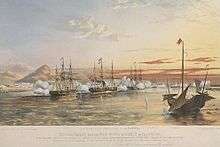HMS Cruizer (1852)
.jpg) HMS Cruiser at Malta in 1894 (as HMS Lark) | |
| History | |
|---|---|
| Name: | HMS Cruizer |
| Builder: | Royal Dockyard, Deptford |
| Cost: | £25,213[1] |
| Launched: | 1852-06-19 |
| Renamed: |
|
| Fate: | Sold at Malta in 1912 |
| General characteristics | |
| Class and type: | Cruizer-class screw sloop |
| Displacement: | 960 tons[1][Note 1] |
| Tons burthen: | 747 51/94 bm[1] |
| Length: |
|
| Beam: | 31 ft 10 in (9.70 m)[1] |
| Depth of hold: | 17 ft 6 in (5.33 m)[1] |
| Installed power: |
|
| Propulsion: | |
| Sail plan: | Barque-rigged |
| Speed: | 6.6 kn (12.2 km/h) |
| Armament: |
|
HMS Cruizer was a 17-gun wooden screw sloop, the name-ship of the Cruizer class of the Royal Navy, launched at the Royal Dockyard, Deptford in 1852. The spelling of her name was formally altered to HMS Cruiser in 1857. She became a sail training vessel in 1872 and was renamed HMS Lark. She was eventually sold for breaking in 1912.
History
Her first years of service were spent on the China station, during which a party of her crew took part in the Battle of Fatshan Creek in 1857. Her commander, Charles Fellowes, was the first man over the walls of Canton when the city was taken,[2] and the ship saw further action on the Yangtse river, including the attack on the Taku Forts on the Peiho river in 1858.
On 20 November 1858, she was in the company of Her Majesty's Ships Furious, Retribution, Dove and Lee. The squadron were conveying the Earl of Elgin on the Yang-Tse-Kiang, when they had to engaged with the Tae-Ping Rebels at Nanking.[3]

In 1860, under the command of John Bythesea she surveyed the Gulf of Pechili to prepare moorings for the Allied fleet to disembark troops for the advance on Peking.
Cruiser was laid up in England in 1867, before being recommissioned for the Mediterranean station.
Disposal
In 1872, having had her guns and engine removed, she became a sail training ship and was renamed Lark, in which capacity she served until at least 1903. She was finally sold for breaking up at Malta in 1912.
Notes
References
- Colledge, J. J.; Warlow, Ben (2006) [1969]. Ships of the Royal Navy: The Complete Record of all Fighting Ships of the Royal Navy (Rev. ed.). London: Chatham Publishing. ISBN 978-1-86176-281-8. OCLC 67375475.
- Winfield, Rif & Lyon, David (2004). The Sail and Steam Navy List: All the Ships of the Royal Navy 1815–1889. London: Chatham Publishing. ISBN 978-1-86176-032-6. OCLC 52620555.
External links
| Wikimedia Commons has media related to HMS Cruizer (ship, 1852). |